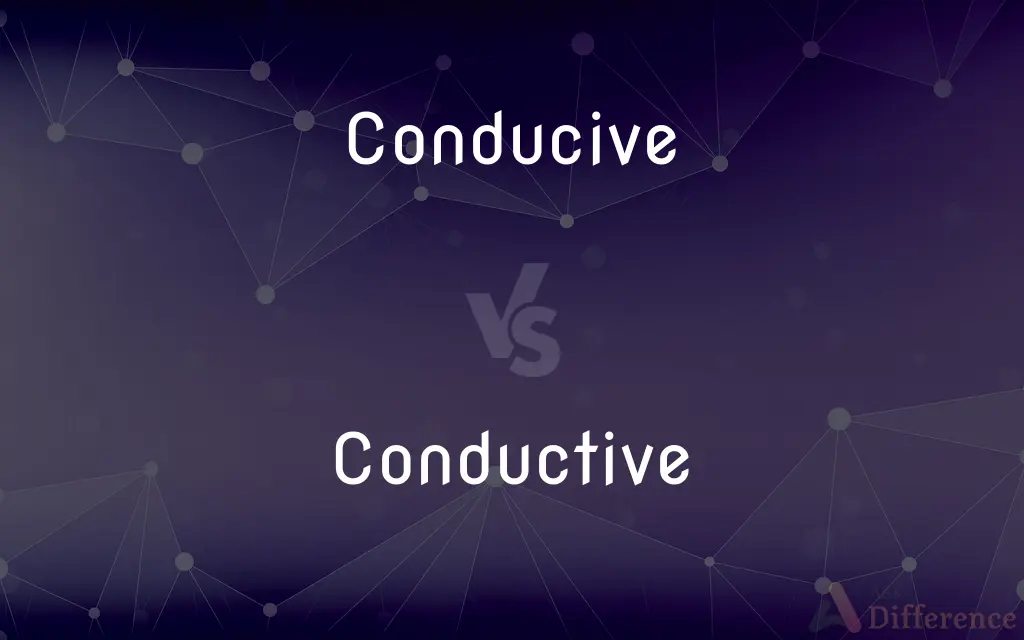Conducive vs. Conductive — What's the Difference?
By Maham Liaqat & Fiza Rafique — Updated on March 25, 2024
Conducive refers to conditions that promote or support an outcome, while conductive relates to the ability of a material to transmit heat, electricity, or sound.

Difference Between Conducive and Conductive
Table of Contents
ADVERTISEMENT
Key Differences
Conducive environments or conditions are those that create a favorable setting for a specific event or action to occur. On the other hand, conductive materials are substances that have the property of transmitting forms of energy, such as heat, electricity, or sound, effectively.
While "conducive" is used in a broad range of contexts, including psychological, environmental, and social scenarios, to describe situations that are supportive or beneficial, "conductive" is used in more technical or scientific contexts. Conductive emphasizes the physical properties of materials that allow them to act as mediums for energy transfer.
The distinction between conducive and conductive also highlights the difference in application areas. Conducive is more about creating positive conditions for various activities or processes, whether they be learning, growth, healing, or productivity. In contrast, conductive is squarely focused on the physical and material sciences, dealing with the fundamental properties that allow objects to carry or move energy.
In discussing design, architecture, education, or business strategies, one might refer to conducive conditions or environments that foster innovation, learning, or efficiency. Conversely, in engineering, physics, or materials science, the conversation would likely center on conductive materials and their applications in technology, energy, and construction.
Both terms, though distinct in their primary usage, underline the importance of the right conditions or properties for achieving specific goals, whether it's creating an environment that promotes a certain activity or utilizing materials that facilitate energy transfer.
ADVERTISEMENT
Comparison Chart
Definition
Refers to conditions or environments that promote or support an outcome.
Relates to the ability of a material to transmit heat, electricity, or sound.
Context
Used in a variety of settings to describe supportive situations.
Primarily used in technical, scientific, or engineering contexts.
Focus
On creating a favorable atmosphere or setting for a desired action.
On the physical properties of materials that allow for energy transfer.
Examples
A conducive learning environment, conducive weather for growing crops.
Conductive metals like copper, conductive materials used in electronics.
Application Areas
Psychology, education, business, environment.
Physics, materials science, electrical engineering, construction.
Compare with Definitions
Conducive
Supporting a positive outcome.
Regular exercise is conducive to good health.
Conductive
Transmitting electricity.
Copper is highly conductive, making it ideal for wiring.
Conducive
Enhancing the likelihood of success.
Open communication is conducive to a healthy relationship.
Conductive
Allowing heat to pass through.
Cast iron pans are conductive and retain heat well.
Conducive
Aiding in the promotion of something.
Warm, humid climates are conducive to the growth of tropical plants.
Conductive
Capable of carrying sound.
Air is a conductive medium for sound waves.
Conducive
Facilitating a desired effect.
Small class sizes are conducive to personalized learning.
Conductive
Used in the context of material properties.
Silver is one of the most conductive metals known.
Conducive
Creating favorable conditions.
The library's quiet is conducive to studying.
Conductive
Relating to the transmission of energy.
Certain polymers can be made conductive for use in electronics.
Conducive
Tending to cause or bring something about; contributive
Working conditions not conducive to productivity.
Conductive
Having the property of conducting something (especially heat or electricity)
A conductive material
Conducive
Tending to contribute to, encourage, or bring about some result.
A small, dark kitchen is not conducive to elaborate cooking.
Conductive
Exhibiting conductivity.
Conducive
Loading or tending; helpful; contributive; tending to promote.
However conducive to the good or our country.
Conductive
Able to conduct electrical current or heat.
Distilled water is very slightly electrically conductive.
Conducive
Tending to bring about; being partly responsible for;
Working conditions are not conducive to productivity
The seaport was a contributing factor in the growth of the city
A contributory factor
Conductive
Of, or relating to conductivity of a material.
Conductive
Having the quality or power of conducting; as, the conductive tissue of a pistil.
The ovarian walls . . . are seen to be distinctly conductive.
Conductive
Having the quality or power of conducting heat or electricity or sound; exhibiting conductivity
Common Curiosities
Can an environment be conductive?
While "conductive" typically refers to materials, in a broader sense, an environment could be described as conductive if it specifically relates to the transmission of physical forces or energies.
Why is it important for a study space to be conducive?
A conducive study space is important because it provides an environment that supports concentration, learning, and academic success.
What does "conducive" mean?
Conducive refers to conditions or environments that are favorable for or supportive of a certain outcome.
What makes a material conductive?
A material is conductive if it has physical properties that allow it to easily transfer electrical current, heat, or sound due to its atomic or molecular structure.
What is an example of a conductive material used in electronics?
Copper is a common example of a conductive material used in electronics for wiring and components due to its excellent electrical conductivity.
How can a business environment be made more conducive to productivity?
Creating a conducive business environment can involve ensuring comfortable workspaces, fostering a positive culture, and providing the tools and resources necessary for efficient work.
How is "conductive" used in science?
Conductive describes the property of a material that allows it to effectively transmit heat, electricity, or sound.
Are all metals conductive?
Most metals are conductive due to the free movement of their electrons, but the degree of conductivity can vary significantly between different metals.
Can a substance be both conducive and conductive?
While the terms address different qualities, a substance or situation could theoretically be described by both if it both supports a positive outcome and transmits energy effectively.
What role does conductivity play in energy transfer?
Conductivity is crucial in energy transfer processes, as materials with high conductivity are essential for efficiently transmitting electricity, heat, or sound in various applications.
Share Your Discovery

Previous Comparison
Sketch vs. Diagram
Next Comparison
Noticeable vs. ObviousAuthor Spotlight
Written by
Maham LiaqatCo-written by
Fiza RafiqueFiza Rafique is a skilled content writer at AskDifference.com, where she meticulously refines and enhances written pieces. Drawing from her vast editorial expertise, Fiza ensures clarity, accuracy, and precision in every article. Passionate about language, she continually seeks to elevate the quality of content for readers worldwide.














































